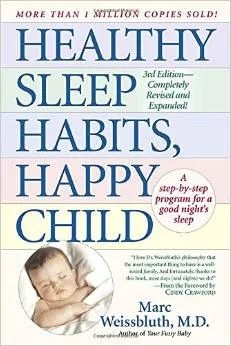
Overview: ‘Healthy Sleep Habits, Happy Child’
Any parent of a toddler who missed a nap can see the train wreck coming from miles away. It won’t be long before that sweet little one is tired, wired, and bouncing off the walls with seemingly unending energy. The crash, as parents know, happens when that energy wanes, heading straight to an emotional meltdown.
That over-tired, excited, emotional state is triggered by a hormone imbalance, according to Dr. Marc Weissbluth the author of Healthy Sleep Habits, Happy Child: A Step-by-Step Program for a Good Night’s Sleep. Without adequate sleep, the brain produces excess cortisol, a stress hormone, and adrenaline. Both hormones can make getting a child to sleep and staying asleep extremely difficult, and without sleep, they get more wound up until a vicious pattern of sleeplessness emerges. Given enough sleep disturbance, Dr. Weissbluth said, those elevated hormones never leave a child’s brain, making them constantly irritable and hyper.
Most parents know the value of a good night’s sleep and regular naps, but what do you do when it just isn’t happening in your house? After nearly a lifetime of studying children’s sleep, Dr. Weissbluth offers a guide for what to expect at every age and stage from infancy to adolescence – and what to do when things go wrong.
He covers the “When should my baby start sleeping through the night?” question and offers parents a plan for the common problems of babies resisting sleep and children getting out of bed after bedtime. Additionally, the book includes a section that addresses special cases like sleep walking, bed-wetting, and night terrors. In that section Dr. Weissbluth also examines the possible links between hyperactivity and sleep patterns.
He also offers advice for parents bringing home a new baby and the impact it could have on sibling’s sleep patterns. What to do when you’re moving, traveling, staying overnight in unfamiliar places, and dealing with illness. He even troubleshoots sleep problems that adoptive parents might encounter.
Healthy Sleep Habits, Happy Child’s thoroughness also hints at the book’s only drawback: it is a dense, often academic read – a full 450-plus pages. However, it is organized well enough that parents can use the book for reference and troubleshooting when sleep problems arise.
At least half of the book examines and provides solutions for the sleep patterns of infants, making the book a great gift for expectant parents.
